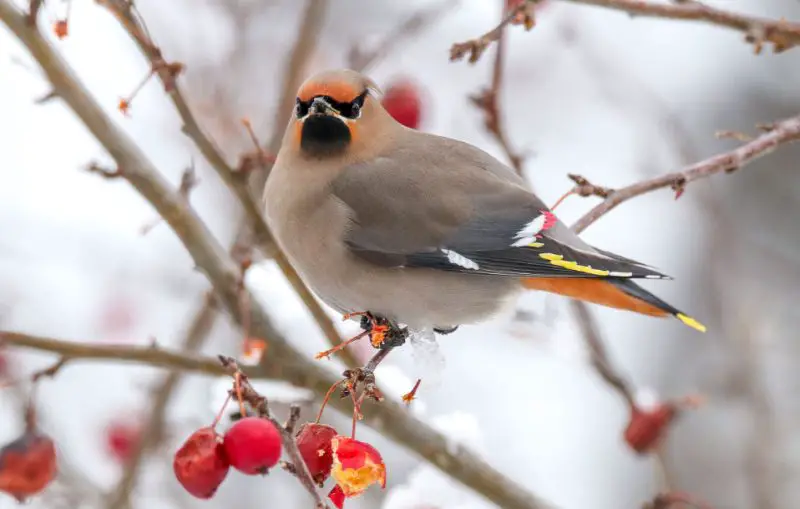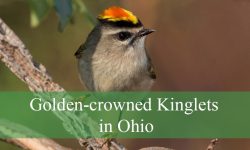Across Colorado’s cold-season scenery, Bohemian waxwings appear as elegant, fast-moving flocks that drift together through frosted trees and open skies. Their soft gray feathers, silky crests, and flashes of orange, yellow, and red create a level of color rarely seen in winter bird communities. Although they appear unexpectedly and vanish just as quickly, their behavior reveals a world of social coordination, unpredictable movement, and specialized winter feeding that sets them apart from nearly any other winter species.
Colorado’s cold-season environment, filled with mountain towns, foothill forests, and berry-rich neighborhoods, offers ideal conditions for waxwings. When food appears, the flocks descend suddenly, filling streets, parks, and trees with constant motion and faint ringing trills. These birds transform quiet winter scenes into moments of intense activity.
This article uncovers the truth about Bohemian waxwings in Colorado winters, exploring their movements, feeding ecology, flock dynamics, vocal behavior, and ecological significance—details that most residents never notice despite the species’ dramatic presence.
Understanding Bohemian Waxwings in Colorado

What Bohemian Waxwings Really Are
Bohemian waxwings are medium-sized, smooth-feathered songbirds built for a life defined by winter travel, cold climates, and long-distance wandering. Their silky gray bodies, boldly patterned black mask, and swept-back crest immediately set them apart from typical winter birds found in Colorado.
Their wing markings—small, waxy-looking red tips and soft yellow tail bands—are not just ornamental. These colors develop from pigments found in the berries they eat, giving the species an appearance directly tied to its diet. As a result, their plumage reflects not only genetics but the quality of fruit available during development.
Waxwings belong to a small, specialized family with only a few species worldwide. All share a similar dependency on fruit-heavy environments and possess adaptations that allow them to survive in regions with long, cold winters. This family-wide fruit reliance shapes everything about their behavior, from their digestive system to their flock structure.
Among their most defining characteristics is their intensely social nature. Unlike solitary or territorial winter birds, Bohemian waxwings travel almost exclusively in flocks. These flocks function with remarkable cohesion, responding instantly to shared cues and moving with fluid precision. Their constant shifting between fruiting trees, perches, and sheltered edges gives them a restless appearance, yet every movement is controlled and purposeful.
Why Colorado Winters Suit Them
Colorado’s winter landscape offers an unusually rich mosaic of fruit-bearing plants. Natural stands of mountain ash, chokecherry, juniper, and serviceberry line foothills and mountain valleys, while ornamental plantings in residential areas add crabapples, hawthorns, and Russian olives that persist deep into winter.
This combination of native and urban plant life creates a dependable food supply that waxwings rely on during their roaming winter journeys. Even after severe cold or heavy snowfall, Colorado retains enough berries to sustain large flocks, making it one of the most reliable wintering locations in the interior West.
Mountain towns such as Steamboat Springs, Durango, and Estes Park often witness sudden eruptions of waxwing activity, especially in years where berry crops remain strong. Urban centers along the Front Range—Fort Collins, Boulder, Loveland—become winter hotspots as ornamental fruit trees shed their foliage but keep their bright fruit accessible.
The state’s elevation gradient also benefits waxwings. As berries become depleted in one region, flocks easily shift between foothills, valleys, and higher-elevation forests. This mobility makes Colorado particularly suited for a species that must constantly track fruit availability.
Where They Occur Across the State
Bohemian waxwings do not appear uniformly across Colorado. Instead, their presence varies depending on berry crops, recent weather patterns, and the availability of sheltered roosting areas.
In foothill towns with abundant ornamental fruit, waxwings may descend by the hundreds, filling trees with constant movement. These areas offer both food and relative protection from strong mountain winds.
In coniferous forests, especially where juniper berries are plentiful, waxwings feed high in the canopy, sometimes mixing with cedar waxwings. The blue and purple juniper fruits provide dense winter nutrition that supports large flocks.
Mountain valleys often experience waxwing influxes after storms push birds downhill or into sheltered, food-rich drainages. These valleys act as concentration zones where multiple flocks merge before dispersing again.
Urban parks are another reliable winter habitat. Here, waxwings move between ornamental crabapples, berry hedges, and tall shade trees, creating short-term feeding bursts that last until fruit supplies are exhausted.
Because waxwings move continuously in search of their next fruit source, their distribution can change daily or even hourly. A tree filled with 200 birds in the morning may be completely silent the same afternoon.
Hidden Behaviors You Rarely Notice
Their Flocking Movements Are Highly Organized
Bohemian waxwings form flocks that operate with near-synchronized precision. When flying, the group shifts direction instantly, almost as if driven by a single mind. Each individual watches the subtle wing movements of its neighbors, creating tight, fluid formations that help the flock avoid obstacles and predators.
As they descend toward fruiting trees, their flight becomes even more coordinated. They spiral downward in graceful loops, landing in staggered waves that prevent branches from overloading. This structured approach ensures equal access to fruit and reduces the chance of any one bird being exposed to predators lurking nearby.
When the flock decides to leave, the takeoff often occurs in a single sweeping motion, with birds launching almost simultaneously—a coordinated departure that reinforces their collective behavior.
They Communicate With Constant, Subtle Trills
Waxwings create a soundscape that often goes unnoticed until one listens carefully. Their communication consists of delicate, high-pitched trills that ripple through the flock as birds move from tree to tree.
These trills serve multiple purposes. They help individuals maintain cohesion during flight, signal feeding readiness, and coordinate departures from feeding sites. Even while feeding quietly among branches, waxwings continuously call to one another, weaving a web of sound that binds the group together.
Their vocalizations are not meant for territorial defense—unlike most songbirds—but for maintaining flock unity, which is essential for survival in unpredictable winter conditions.
They Are True Winter Wanderers
Bohemian waxwings do not defend territory, nor do they settle into fixed winter ranges. Instead, they roam widely, sometimes covering dozens of miles in a single day. Their movement patterns follow berry cycles: once a food source is depleted, the flock moves on without hesitation.
This nomadic lifestyle explains why some Colorado winters see thousands of waxwings, while others see almost none. Their presence is dictated by berry production in the northern states and Canada. When those crops fail, waxwings move southward in a phenomenon known as an irruption. Colorado often becomes a major destination during these irruptive years.
Their flexibility allows them to survive in some of the harshest winter climates on the continent.
Anatomy Built for Winter Survival
Dense, Insulating Plumage
Bohemian waxwings rely on exceptionally dense feathers to survive freezing temperatures. Their plumage forms insulating layers that trap pockets of warm air close to the skin.
This dense feathering allows waxwings to remain in exposed treetops for extended periods without losing critical heat. Even during snowstorms, they continue feeding calmly, protected by their built-in insulation.
Their sleek feather structure also contributes to aerodynamic efficiency, reducing wind drag during fast flock flights.
A Bill Perfect for Fruit Consumption
Waxwings possess a short, triangular bill that is optimized for rapid berry plucking. Unlike species that must crush or tear their food, waxwings swallow small fruits whole—an adaptation that allows them to feed quickly before the flock moves again.
This bill shape is extremely efficient in winter when time spent feeding must be balanced with time spent maintaining warmth and avoiding predators.
Their digestive system is equally specialized, enabling them to extract nutrients from fruit at high speed, a key advantage in cold environments where metabolic demands are high.
Strong Wings for Fast, Agile Flight
Waxwings depend on rapid, agile flight to stay with their flock and escape predators. Their wings beat quickly and steadily, giving them the ability to make sharp turns and weave through branches during mass landings.
Their flight style allows them to remain tightly grouped even when navigating complex environments such as urban neighborhoods or dense berry patches.
In open areas, waxwings often perform swift, low-level flights between trees, maintaining impressive speed despite winter winds.
Feeding Habits Across Colorado Winters
Their Diet Is Almost Entirely Fruit
Waxwings rely heavily on fruits such as crabapples, chokecherries, junipers, hawthorns, Russian olives, and mountain ash. These berries remain available long after leaves fall, giving waxwings consistent winter access to energy-rich food.
During extremely cold spells, some fruits ferment slightly, producing small amounts of alcohol. Waxwings occasionally consume them, leading to brief, harmless disorientation—a phenomenon familiar to many mountain-town residents.
Their ability to process fruit rapidly is essential for maintaining body heat in freezing temperatures.
Rotational Feeding Behavior
One of the most distinctive waxwing behaviors is their rotational feeding system. Rather than crowding branches, individuals take turns moving toward the ripest fruit clusters, ensuring that every bird receives adequate food.
This calm coordination stands in stark contrast to the aggressive feeding behaviors seen in many winter birds. Waxwings rarely fight and rely instead on flock-level cooperation to maximize food access.
Occasional Insect Feeding
Although fruit dominates their winter diet, waxwings will opportunistically catch insects during warmer afternoons. Small midges, beetles, and snow-emerging insects offer supplemental protein that supports immune health and long-term vitality.
This behavior is especially common in February and March when insects begin appearing along sunlit river corridors.
Nesting and Breeding—But Not in Colorado
Bohemian waxwings never breed in Colorado. Their nesting sites lie far to the north in Canada and Alaska, where summer insect abundance provides essential nutrition for raising chicks.
Because their breeding cycle depends heavily on insects—not fruit—Colorado’s winter resources are unsuitable for nesting. Thus, waxwings remain exclusively winter and migration visitors during their time in the state.
Courtship displays, nest construction, and chick rearing are behaviors Colorado observers will never witness locally.
Bohemian Waxwings Across Colorado Landscapes
Mountain Towns and Forest Edges
Waxwings frequent mountain communities where ornamental fruit trees are abundant. They move between neighborhoods and nearby conifer edges, consuming berries throughout the day before retreating to sheltered roosts.
Foothill Communities
Along the Front Range, towns planted with crabapples, hawthorns, and mountain ash become magnets for waxwing flocks.
After snowstorms, these areas often experience dramatic surges in waxwing activity as birds shift downhill seeking accessible fruit.
River Valleys and Drainages
Riparian corridors with fruit-bearing shrubs and trees create winter feeding highways. Moisture in these areas helps preserve berries longer, supporting large flocks for extended periods.
Urban Parks
Parks in cities like Boulder, Denver, and Fort Collins function as temporary feeding stations. Waxwings move through quickly, stripping fruit before shifting to the next site in their wandering circuit.
Seasonal Rhythms in Colorado
Early Winter Arrival
Bohemian waxwings typically arrive from late November through January. Their timing depends on northern berry crops and early winter storms that push flocks southward.
Midwinter Flocks
During peak winter months, waxwing groups become large, mobile, and unpredictable. They may appear suddenly in residential areas, fill trees with swirling motion, and depart moments later.
Late Winter Dispersal
By late February or March, berry supplies diminish. Flocks begin heading north or dispersing into mountain foothills where late-winter fruits persist.
Interaction With Other Wildlife
Birds
Waxwings often feed alongside robins, starlings, and other frugivorous species. Their courteous, coordinated feeding reduces conflict even in dense feeding clusters.
Predators such as sharp-shinned hawks occasionally target waxwings, but the flock’s synchronized flight reduces risk.
Mammals
Squirrels, raccoons, and small mammals sometimes feed on the same berry trees. Interactions are generally passive, as waxwings prefer higher branches and remain in constant motion.
Insects
Though primarily fruit eaters, waxwings occasionally catch insects. This foraging supplements their diet and helps maintain insect population balance during winter months.
Myths and Misconceptions
Myth: Waxwings Are Rare in Colorado
They are regular winter visitors, but their wandering flocks make sightings unpredictable and irregular.
Myth: Their Wing Colors Come From Genetics Alone
Their richest reds and yellows come from carotenoid pigments obtained from berries, meaning diet strongly influences appearance.
Myth: Waxwings Stay in One Area All Winter
They roam constantly, tracking fruit availability across broad regions and moving whenever food dwindles.
Ecological Importance
Berry Dispersal
Waxwings disperse seeds across wide areas, helping regenerate fruit-bearing plants and maintain plant diversity.
Winter Food Web Support
By consuming late-season berries, waxwings prevent fruit buildup, shaping how winter ecosystems function and influencing animal movement.
Indicators of Berry Crop Cycles
Large waxwing flocks signal strong berry production. Their movements help ecologists assess vegetation health and seasonal fruit cycles.
FAQs About Bohemian Waxwings in Colorado
Are Bohemian waxwings common in Colorado?
They appear regularly in winter, though their numbers vary yearly.
What do waxwings eat in winter?
Mostly berries from crabapples, chokecherries, junipers, hawthorns, and mountain ash.
Why do they travel in such large flocks?
Flocking improves feeding efficiency and helps avoid predators.
Do they breed in Colorado?
No. They nest far north in boreal forests.
Why are they unpredictable?
Their movement depends entirely on berry abundance and weather.
Are waxwings noisy birds?
They communicate with soft, high trills that follow them wherever they travel.
Conclusion
Bohemian waxwings bring color, motion, and surprising complexity to Colorado’s winter landscapes. Their nomadic flocks, fruit-heavy diet, synchronized flight, and sensitivity to seasonal berry cycles make them one of the most fascinating winter visitors in the state. Understanding their hidden behaviors allows residents to appreciate these elegant travelers each time they sweep into Colorado’s snowy towns and foothill forests.






